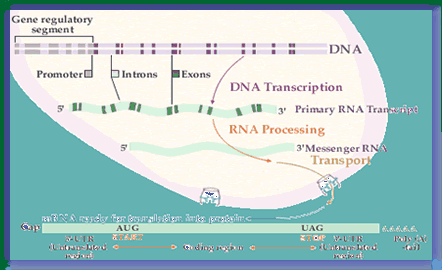DNA and Genes
A gene is a discrete sequence
of DNA nucleotides.

Mendel described a gene as a discrete unit of
heredity that influences a visible trait. Beadle
and Tatum defined a gene as the directions fro
making a single protein, which influences a metabolic
trait.
Early sequencing efforts showed that proteins
are, in turn, long chains of amino acids arranged
in a specified order. The triplet genetic code
future refined the definition of a gene as a discrete
sequence of DNA encoding a protein beginning with
a "seat" codon and ending with a "stop"
codon.
Gene analysis took a giant step forward with
the discovery of methods to determine the exact
sequence of nucleotides that compose a specific
gene. DNA sequencing was built upon earlier knowledge
of DNA polymerizes and cell-free systems for replicating
DNA.
The chain-termination method, which makes
clever use of a "defective" DNA nucleotide,
now dominates DNA sequencing technology.
Without a sophisticated technique for determines
base sequence, one can't distinguish bacterial
DNA from human DNA. This is because all DNA molecules
have the same general chemical properties and
physical structure.
Proteins, by comparisons,
are a much more diverse group of molecules with
a much greater complexity of structure and function.
In his account of the discovery of the double
helix, crick referred to this difference when
he said that "DNA is, at bottom, a much less
sophisticated molecule than a highly evolved protein
and for this reason reveals its secrets easily."
There are four basic DNA "secrets",
embodied in four questions:
- How does the molecule carry information?
- How is that information copied for transmission
to future generations?
- What mechanisms allow the information to change?
- How does the information govern the expression
of phenotype?
The double helical structure of DNA provides
a potential solution to each of these questions,
endowing the molecules with the capacity to carry
out all the critical functions required of the
genetic material.
|

